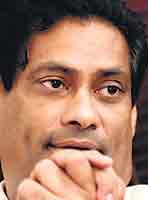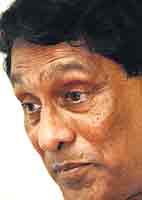
Those crucial momentsThe Kurunegala Teaching Hospital’s new emergency service could help save many lives.
Popular actor Ravindra Randeniya is about to light the traditional oil lamp at a heavily-attended ceremony. Amidst the smiling people, he suddenly clutches his chest and falls. While the adults look on in stunned inactivity, schoolchildren rush forward from the audience and one administers mouth-to-mouth resuscitation, shouting for someone to call 110. As cardiopulmonary resuscitation (CPR) is continued, the ambulance arrives and Ravindra is whisked off to hospital. He recovers to tell the story. Ravindra has not got a heart attack in actual life. He is just acting out the scene to make an indelible mark on anyone who views this video clip. For, just before that a young couple is depicted leaving a store, when the man gets a heart attack. He's bundled into a car but dies on the way.
These two video clips, part of a public awareness campaign, are juxtaposed to show the important steps essential to make sure a person who "drops" due to any one of numerous reasons, the foremost being a heart attack, survives up to the time of admission to hospital. CPR, a combination of rescue breathing (mouth-to-mouth resuscitation), chest compressions and a few other measures, can save a life by restoring breathing and circulation until advanced life support can be provided by medical staff. Without oxygen, permanent brain damage or death can occur. "Currently in Sri Lanka, no such response follows an emergency like that and in most cases people die," says Kurunegala Teaching Hospital Director Dr. Ananda Gunasekera, who along with several others has initiated a programme in the area to change this. In a situation like that usually emotions take precedence, with kith or kin attempting to pour water down that person's throat, weeping or wailing or even attempting to force a piece of iron into his mouth. This is what they are hoping to change, firstly in the Kurunegala region through the two-pronged Life-saving Training Service and Life-saving Deployment Service. Installing the emergency 110 hotline at the Kurunegala Hospital, geared to answer emergency calls round the clock, with an ambulance and staff ready to take off within five minutes, equal importance has also been given to training men, women and children from different offices and schools to administer the first essential measures to keep a person alive until the ambulance arrives. The other 110 service in the country is operated in Colombo by the Fire Brigade."Most people don't get a heart attack or face a health crisis close to the hospital," says Dr. Gunasekera, explaining that it can happen anywhere…on the road, in the bus, at home, in a playground, in the office. From January, Kurunegala Hospital staff have trained more than 3,000 people including 500 schoolchildren to give basic life support until the equipped ambulance with a doctor and a nurse on board arrives to give advanced life support while the patient is being taken to hospital. "The triage desk of the hospital will also be ready and in contact with the ambulance staff to direct the patient, most probably to the ICU without any delay," stresses Dr. Gunasekera. The beginnings of this crucial emergency service lie in a meeting Dr. Gunasekera had with a Sri Lankan doctor living in Melbourne, Australia, a couple of years ago. Dr. Ranjith Hettiarachi, an Obstetrician and Gynaecologist, has stark memories of instant deaths which he had seen back home when he was a junior doctor and wanted to help Sri Lanka save as many lives as possible, 40 years later. "It was also time for me to give back all that I had got from Sri Lanka, like the free education which helped me become a doctor," he says humbly.
Concerned about the "drop dead" instances of Sri Lankans, who are prone to sudden death, the discussion Dr. Hettiarachi had with the Kurunegala Hospital Director saw him making a 10-point plan somewhere in 2006 and deciding to use Dr. Gunasekera as "a cat's paw" to implement the programme. "I felt he could execute the work," says Dr. Hettiarachi. It required big money but Dr. Hettiarachi and wife Pushpa wanted to see it take shape and channelled their own personal funding, through the Sri Lanka-Australia Charitable Health Fund. Health Minister Nimal Siripala de Silva has not only supported this hospital-based emergency service but has also signed an MOU with the Fund. Then came the decisions. Whom do you train in CPR? That's when they visited six schools in Kurunegala and began with children over 15 years of age, who would also carry this important message home. There followed the training of people in the AGA, telecom and electricity offices along with those at the Municipality and also the police, the army and the three-wheel associations in the area. "In society, ideally there should be at least 1 in every 100 trained in CPR," says Dr. Hettiarachi and if it is administered within the first minute to the patient, there is a 70% chance of survival. "For every minute of delay, the patient loses 10% chances of full recovery." While the training programme continues, Teleview, an advertising agency, has taken up as its corporate social responsibility the making of the video clips to create public awareness on the importance of emergency care before a patient is taken to hospital. For the young man in the video clip, the worst was being taken in a car. The ideal would have been, in the absence of an ambulance, a van where he could have been kept flat on his back and CPR not only begun but also continued until hospital admission, says Dr. Hettiarachi. Many lessons not only for Kurunegala but also for the whole country. Already Kegalle, Badulla and Ratnapura Hospital officials have sought assistance to set up similar services and Dr. Gunasekera hopes the Health Education Bureau will propagate this concept. The Health Ministry should replicate it across the country to save all those people, who have a close encounter with death, within those crucial first few minutes. |
|
||||||
|| Front
Page | News | Editorial | Columns | Sports | Plus | Financial
Times | International | Mirror | TV
Times | Funday
Times || |
| |
Reproduction of articles permitted when used without any alterations to contents and a link to the source page.
|
© Copyright
2008 | Wijeya
Newspapers Ltd.Colombo. Sri Lanka. All Rights Reserved. |


